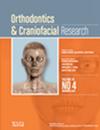Effect of orthodontic space closure on dental pulp sensitivity. Prospective clinical trial
Abstract
Background
Orthodontic tooth movement (OTM) is a biological process that can influence the function of the pulp, including its innervation. The excitability of the nerve fibres of the pulp may be altered by forces exerted on the nerve fibres or by reduced blood flow to the pulp. The aim of this clinical study was to evaluate the sensitivity of the dental pulp during levelling and during the phase of space closure, to assess the role of certain controlled risk factors.
Methods
Twenty-two adolescent participants requiring orthodontic space closure in transcanine sector were enrolled in a prospective clinical study. Patients were observed before OTM, after levelling and 1 month during active space closure. The sensitivity threshold of the pulp was measured using the electric pulp test (EPT). Dental models were obtained using an intraoral scanner, allowing measurement of interdental distances and calculation of OTM speed. The teeth were categorized according to position and tooth type.
Results
The EPT values increased significantly during orthodontic treatment (one-way RM-ANOVA, P = .014). There was a significant difference in EPT values between the tooth categories. Teeth with a single root adjacent to the residual space had the highest EPT thresholds (two-way RM-ANOVA, P < .001; Holm-Sidak, P < .05).
Conclusions
OTM reduced pulpal sensitivity. Pulpal sensitivity during active space closure was similar to sensitivity during the levelling phase. The pulpal sensitivity of molars was less affected by OTM than that of single-rooted teeth, while teeth closer to the gap had a significantly higher pulpal sensitivity threshold during active OTM.


 求助内容:
求助内容: 应助结果提醒方式:
应助结果提醒方式:


